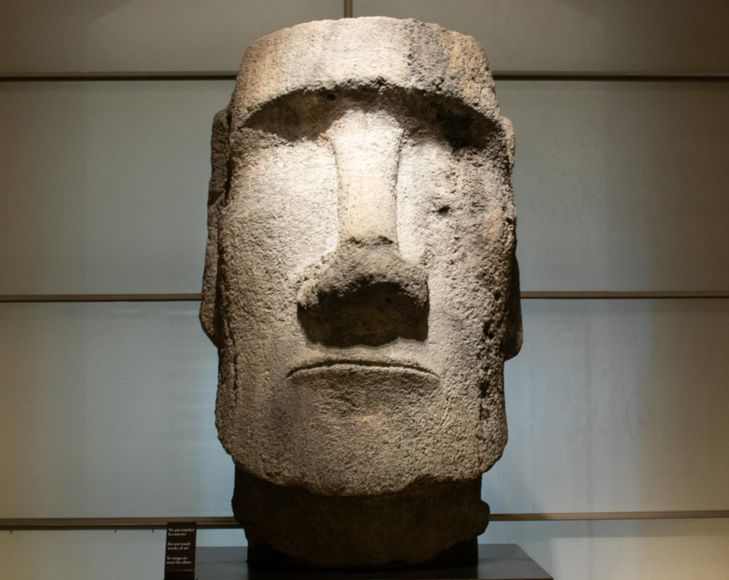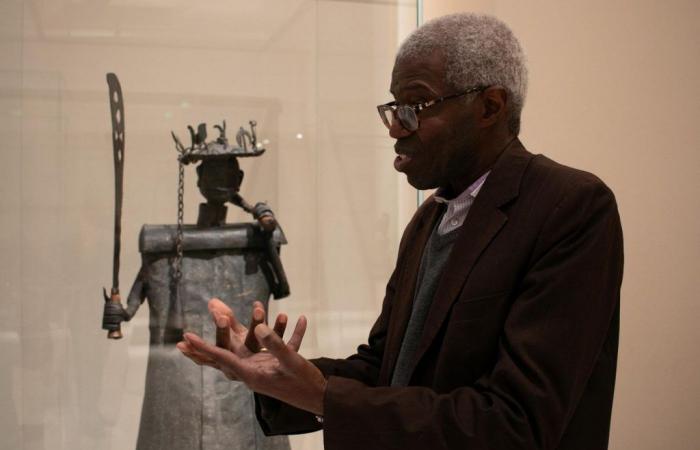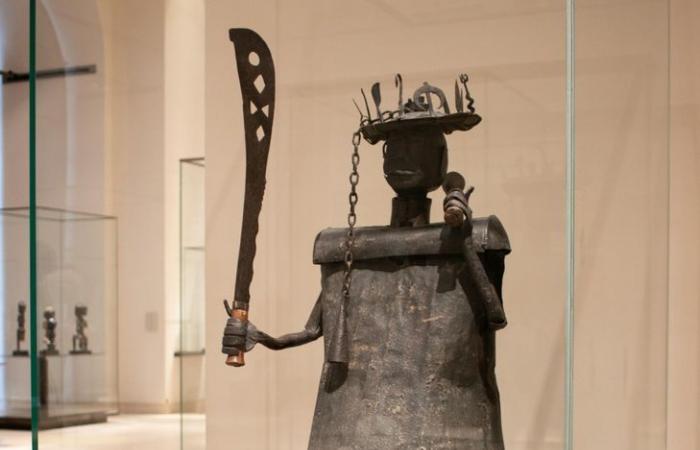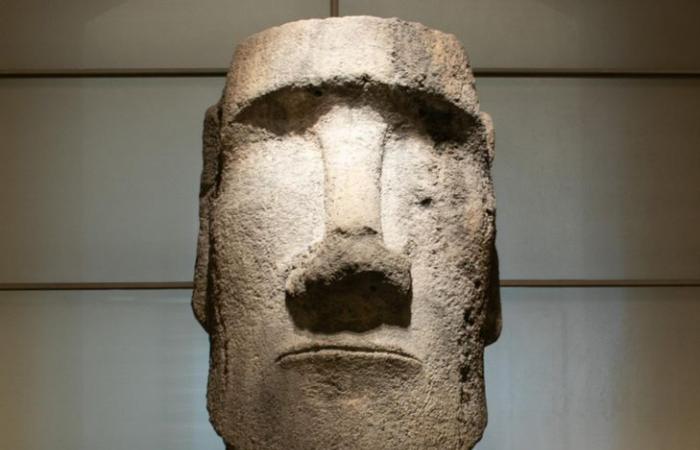The Cross : We are at the Louvre, where you are preparing to give five conferences on the links that this museum maintains with the works from around the world exhibited there. Do you feel confronted, here, with a colonial narrative, which celebrates France at the center of the world, as some voices denounce?
Souleymane Bachir Diagne: I had this idea of the Louvre until the inauguration, in 2000, of the Sessions pavilion (devoted to the arts of Africa, Asia, Oceania and the Americas, Editor’s note). From then on, I began to reconsider this notion of an overhanging narrative, draped in its universality, and to tell myself that, in a certain way, this Sessions pavilion welcomed these objects into their home.
How can some of these objects be at home here when they were taken during colonial times?
S. B. D. : Basically, my position is that of the former director general of UNESCO, the Senegalese Amadou Mahtar M’Bow, who has just disappeared. At the end of the 1970s, he launched a vibrant appeal for the return of the heritage of the former colonies, but at the same time, he recognized that this heritage had taken root in his borrowed land. Little by little, this idea gained a central place in my thinking and I considered that these objects were not only exiled awaiting a return, but that they had created something here.
My conviction was reinforced that by welcoming them, the Louvre was achieving its own purpose, that of decentering itself, of opening itself to what shakes up the idea of a truly European universalism, overlooking, closed in on itself.
What did these objects create in Europe?
S. B. D. : They contributed a lot to contemporary art of the 20th century. Picasso is the best proof of this. More generally, they presided over an Africanization of the world during the colonial era, where precisely a form of Europeanization of the world took place. Moved by force to Europe, they produced a dynamic there which testified to their vital force. We can never emphasize this enough. Their presence in a museum can no longer be explained only by the hand that tore them from their land of origin, but now also by the meaning they give to this museum. These objects are not victims. They are agents.
How can we highlight this role in the museum space?
S. B. D. : Here at the Louvre, two projects are underway. First, a greater opening, on an architectural level, of the Sessions pavilion in order to break its isolation. For the moment, visitors only come if they intend to. Work (scheduled until fall 2025, Editor’s note) should make it possible to integrate it into the museum itinerary. Then there is what I call “relatedness”, the act of thinking of objects together, of making them speak.
After the work, “the blue man” (anthropomorphic sculpture from Vanuatu, Editor’s note) should be next to an ancient statue. Talking to other objects is what “being at home” means for an object here. This will be the theme of one of my conferences: ” When The Mona Lisa smiles at the dimpleless masks.”
According to you, the restitutions in progress are not necessary…
S. B. D. : Many formulas are possible. The way in which Germany negotiated with Nigeria around the Benin bronzes, which are very clearly war spoils, is interesting. Some will return to Nigeria and others will stay in Germany. In my eyes, the violent, decolonial gesture of saying that everything African must be returned is absurd. It destroys the story of how these objects found their place elsewhere and cancels the relationship that was established.
Restoring ownership of objects is nevertheless important, because it is an act of repair and recognition. However, the process is simpler for objects that are real spoils of war than for others. Some have in fact been acquired, colonization having not only been a space of pure violence, but also a space of exchange. Likewise, the question of the provenance of objects is important. This must be established, which takes time, and indicated. It is a way of understanding the nature of these objects, which is to be shared.
This is also how we preserve the universal, but a universal that I would describe as “lateral”, a universal that comes out of itself and includes the idea that cultures speak to each other. Even when they collide in violence, they always end up dialoguing and creating a common language.
“We must not abandon the concept of universal”you write. Can you remind us of what is at stake in protecting it?
S. B. D. : To destroy the universal is to destroy the idea of humanity. However, this is the result that we achieve if we consider that cultures are juxtaposed humanities. I also emphasize this in my book: it is no coincidence that an extreme right-wing thinker (philosopher Alain de Benoist, Editor’s note) considers that there are only humanities that must remain separate and that humanity in the singular is at best a zoological notion.
This is exactly the definition of apartheid: separate development, based on the belief that human cultures are not meant to mix. However, because a culture is human, it speaks to humanity. In other words, each culture gestures to the whole of humanity. Nothing shows this better than artistic creations.
You mention the « performances identitaristes » which contribute to the fragmentation of cultures. Where are they played?
S. B. D. : Particularly in the idea that I cannot speak about a culture if I am not myself from that culture. This can go as far as the novelist wondering if he has the right to give voice to a character who does not share his identity. This way of watching over identities like Cerberus is the negation of the old humanist words “I am human and nothing that is human is foreign to me”. The fragmentation of cultures contradicts the idea of the orientation of the plurals of the world towards a horizon of universality, as Jean Jaurès said. Humanity must be our compass. We must build a politics of humanity that does not deny the plurals of the world. A museum like the Louvre can participate.
———-
Fang mask, 19th century, Gabon, from the Ngil secret society in wood, kaolin and brass nails
Fang mask from the Ngil secret society, 19th century, Gabon. / Capucine Barat–Gendrot / for La Croix
“This mask illustrates the Africanization of modern arts. We know that Picasso’s creation was influenced by African objects. He discovered them in particular at the painter André Derain, who was a collector and owner of a fang mask which had a great impact on him. It is also a good illustration of what Senghor wrote about the geometric meaning of objects. Look at this play of convex and concave lines. They do not respond to a concern for proportion, but for the transposition of rhythm. They represent, in a way, “rhythm series”as Senghor said. What needs to be represented here is not the thing, but the essence of the thing. »
Fon sculpture, attributed to Akati Ekplekendo, before 1858, Benin, statue dedicated to Gou, divinity of iron and war in iron and wood
Fon sculpture attributed to Akati Ekplekendo, before 1858, Benin. / Capucine-BARAT–GENDROT Capucine Barat–Gendrot / Capucine Barat–Gendrot
“This “god of iron”, who comes from Benin, brings up the question of restitutions to me. In the movie Dahomey (1), Beninese students deplore its absence among the 26 objects that France returned to their country. For my part, I can see him staying here. This object is at home in the Louvre. Of course, we can imagine a loan and even a transfer of property to the State of Benin. However, ownership must be detached from location. The objects in the Louvre are intended to be nomadic. This “god of iron” also shows the diversity of African art. It is not just about masks and can use European materials. »
Monumental moai head in basalt tuff, Easter Island

Monumental moai head sculpture, Easter Island. / Capucine Barat–Gendrot / Capucine Barat–Gendrot
“This object fascinates me. Not much is known about Easter Island’s sculptures or its cosmology. They are only considered to represent protective deities. However, this head, carved in the rock, of monumental scale, with its closed eyes, captivates me. Like the “iron god” of Benin that I just spoke about, it points towards transcendence, but in a different way. It is, in a way, the meeting of a transcendence and an absence. This object not being African, there is a relationship built between the two of us. This is proof of its universal dimension. I tell myself that by taking this chair at the Louvre, I am placing myself under its protection. »
(1) In this film, winner of the Golden Bear in Berlin this year, Franco-Senegalese director Mati Diop follows the return to Benin of 26 objects returned by France, which had looted them during the colonial era, as well as the debates provoked on this occasion between students from Cotonou.








